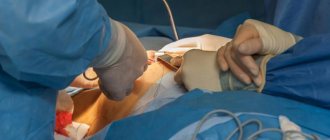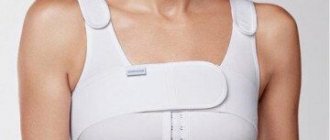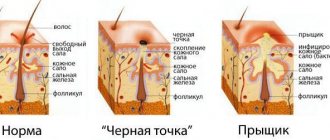The mammary gland is a distinctive feature of an entire zoological class - the class of mammals.
From the birth of a child to the later years of life, the mammary gland changes its appearance many times - starting with a small bud, it goes through its exciting heyday and ends its life in fading calm.
The mammary glands begin to form in the 6th week of intrauterine life. From the moment of birth until puberty, the ducts in the mammary glands lengthen and the nipples enlarge. During puberty, rapid lengthening and branching of the ducts, formation of glandular lobules, and changes in the morphological structure of the mammary gland occur. Connective tissue forms 2 zones: intercellular and interlobar (supporting lobes), subject to hormonal influences. After full puberty, the mammary gland stops developing until the second trimester of the first pregnancy. Thus, from puberty until the end of the first pregnancy, the epithelium of the mammary glands is immature, it is not able to respond to its own circulating progesterone, and this becomes a risk factor in the development of breast cancer.
The mammary gland is extremely dependent on the cyclical physiological processes of the body. In practice, the mammary gland is never at rest, regardless of the woman’s age. Constant variability in the structure of the mammary gland, sensitivity to sex hormones, thyroid hormones, dependence on sexual comfort and the state of the emotional status of a woman, lead to the frequent occurrence of dysplastic processes in this gland, which are most often combined with the term mastopathy or fibrocystic disease.
Mastopathy or fibrocystic disease is a general name for benign changes in the mammary glands, which differ greatly in anatomical features, clinical manifestations and the danger of malignancy, which forces us to consider mastopathy as a precancerous disease.
Causes of the disease
There are a huge number of reasons for the occurrence of pathology. The main ones are:
- Stressful situations that are present in the life of every woman (dissatisfaction with their marital status, as well as their position in society, domestic conflicts, conflict situations at work) since any stress is accompanied by various functional disorders of the neuroendocrine system.
- Factors of a sexual nature.
- Reproductive factors (number of pregnancies, births, abortions, age at pregnancy and childbirth, duration of lactation, time of first menstruation and menopause, etc.).
- Gynecological diseases and, first of all, inflammatory processes in the pelvis.
- Endocrine disorders (thyroid dysfunction, metabolic syndrome, polycystic ovary syndrome, diabetes mellitus types 1 and 20, etc.). Pathological processes in the liver and bile ducts. Hereditary (genetic) predisposition.
Causes of mastopathy
WHO considers the cause of mastopathy or fibroadenomotosis dishormonal changes that can occur with:
- disruption of hormone synthesis during an unstable menstrual cycle
- for problems with the thyroid gland
- in case of metabolic disorders with excess body weight (adipose tissue itself synthesizes estrogens - ovarian hormones of the first phase of the cycle).
- late birth and short duration of breastfeeding.
WHO does not consider options for dishormonal changes due to consumption of cheap foods with hormones - broiler meat, animals and fish that received hormonal growth stimulants; animal tissues with a high content of endogenous hormones - udder, adipose tissue, uterus, ovaries, milk - which are not thrown away, but processed and used for the manufacture of cheap semi-finished products. A number of plant products contain substances that are not actually hormones, but which our body perceives as hormones - hops in beer, soy, palm oil components. When consumed regularly, they can also cause dishormonal changes and provoke not only mastopathy.
Normally, a passage of secretion occurs in the mammary gland: hormones of the corpus luteum - phase II of the cycle initiate the proliferation of cells of the mammary gland lobules (which secrete milk during feeding) - as preparation for a possible pregnancy - without pregnancy, their regression occurs. The cells of the lobules die and the products of their death move along the ducts towards the nipple, where what is left of them is absorbed in the sinuses. In mastopathy, due to dishormonal changes, the process of proliferation in the lobules is more pronounced. As a result, more regression products of these cells appear, which form clusters (cysts). Severe regression promotes aseptic inflammation and the formation of connective tissue. With a deficiency of vitamins A, E and D, rough scar tissue forms at the site of regression, disrupting the movement of secretions and aggravating the problem in subsequent cycles.
Pregnancy and breastfeeding help normalize the condition of the mammary glands, while abortion provokes a non-physiological hormonal shock to the mammary gland tissue.
The synthesis of all hormones occurs mainly at night from 23:00 to 3:00, provided that the person is already sleeping at this time. For this process to occur normally, you need to go to bed after 10:00 p.m. It is believed that this process is also negatively affected by excessive lighting. At night, during sleep, all the damage that happened to the body during the day is restored. Lack of sleep and light pollution from artificial lighting disrupt the natural process of hormone synthesis and body restoration, causing illness.
Also, excess Na+ content also contributes to fluid retention in the body. Each sodium ion can hold up to 4 water molecules. Sodium ions are part of sodium glutamate (a flavor enhancer - a food additive for cheap food) and salt (NaCl), which is found in abundance in processed foods, sauces and seasonings.
Symptoms of mastopathy
For mastopathy, the most typical complaints are:
- breast tenderness,
- a feeling of increasing their volume,
- engorgement and swelling of the glands,
- the presence of clear or colostrum-like fluid discharge from the nipples of the mammary glands.
Pain may radiate to the armpits, shoulder and shoulder blade. The most common is a combination of symptoms of mastopathy and premenstrual syndrome. The main complaints in these conditions are: headache (often migraine-type), swelling of the face and limbs, nausea, less often vomiting, impaired bowel function, flatulence. With the neuropsychic form of premenstrual syndrome, complaints such as irritability, depression, weakness, tearfulness and aggressiveness may be associated. Difficulties in determining the cause of pain are due to the fact that pain can occur not only with pathology of the mammary gland, but also with cervicothoracic osteochondrosis, radiculoneuritis, intercostal neuralgia and is eliminated with appropriate therapy.
Basics of rehabilitation after mammoplasty against the background of mastopathy
The operation itself and the early recovery period are no different from the standard ones. For a month, physical activity is limited, constant wearing of a bandage and careful adherence to personal hygiene rules are recommended. After surgery, you may experience periodic pain or discomfort in the breast area. Most often, these symptoms are associated with existing mastopathy and do not depend in any way on the mammoplasty performed.
Some plastic surgeons note that patients with fibrocystic mastopathy have a higher risk of a specific complication - capsular contracture. Its occurrence is associated with the growth of coarse fibrous tissue around the implant capsule and subsequent deformation of the breast. The appearance of capsular contracture is a predictable process, directly related to the degree of connective tissue changes and structural features of the patient’s breast. In case of severe fibrous growths in the breast tissue, it is recommended to refuse mammoplasty.
What forms can fibrocystic disease have?
Most often, mastopathy is diffuse in nature and manifests itself:
- predominance of the glandular component (edema, proliferation of glandular tissue) - the most favorable form;
- the predominance of the fibrous component (swelling, enlargement of interlobular connective tissue septa, their pressure on the surrounding tissue, narrowing of the lumen of the ducts, up to their complete fusion;
- the predominance of the cystic component (the presence of one or more elastic cavities filled with liquid contents, clearly demarcated from the surrounding tissues of the gland);
- mixed form (increased number of glandular lobules, proliferation of connective tissue interlobar septa).
A less favorable form of mastopathy is nodular. In this form, as a rule, against the background of the changes described above, there is the presence of one or more nodes, most often representing an adenoma or fibroadenoma.
Fibroadenoma is a fairly common benign tumor of the mammary glands. Occurs at any age, but more often in 20-40 years. In some cases, especially in adolescents, fibroadenomas can grow quickly and reach significant sizes (up to 10-15 cm). According to various authors, the degeneration of benign fibroadenoma into a malignant breast tumor occurs in 1.5-2%.
Also, the nodular form can be represented by atypical hyperplasia (proliferation of glandular tissue). The percentage of degeneration of this nodular formation increases to 20%.
It is also worth recalling a very special manifestation of mastopathy - bloody discharge from the nipple of the mammary gland. As a rule, the cause of such discharge is an intraductal formation (papilloma), which can ulcerate and bleed. Such symptoms should be a serious cause for concern for a woman and promptly seek medical help.
One operation or two consecutive?
Before undergoing surgery, the patient is given a complete diagnosis of the body’s condition, the presence of allergies and various diseases is identified. As a result of a thorough examination of the mammary glands, many women first learn that they have a fibroadenoma, cyst, or other type of benign tumor. The tumor must be removed in any case, but what about aesthetics? Many doctors suggest separating tumor removal and cosmetic surgery, but this is by no means the only best choice.
In such a large and well-equipped center as ours, it is possible to solve both problems at a high level during one surgical intervention. This saves the patient time and finances, makes it easier to cope with the emotional stress of the operation and eliminates the risk of unnecessary incisions and unsightly scars on the chest. After all, plastic surgeons always pay special attention to ensuring that no noticeable traces of surgery remain on the body.
Diagnosis of mastopathy
Necessary examination methods that a woman should receive when visiting a mammologist:
- examination and manual examination of the mammary glands, examination of the axillary, subclavian, cervical lymph nodes;
- Ultrasound of the mammary glands and lymph nodes;
- x-ray mammography (all women over 40 years of age);
- blood tests (general analysis, biochemical study, hormonal status, tumor markers);
- when cysts are detected, puncture them with cytological examination of the contents;
- when a nodular formation is detected, cells are collected from the formation using a needle and syringe for cytological examination.
Breast correction and fibroadenoma
What breast implants do we offer?
Wondering how to enlarge breasts without surgery and studying and even trying different techniques, many women come to the conclusion that this is impossible. This is why many people decide to undergo augmentation mammoplasty, which allows them to achieve a bright and long-lasting effect. The operation can also be performed in the presence of fibroadenoma. The implant is not placed in the glandular tissue, but under it or under the pectoral muscles, which eliminates its contact with the area affected by the tumor.
Breast plastic surgery allows you to achieve excellent results even after fibroadenoma removal. Thanks to it, you can adjust the shape and volume of the mammary glands and improve their appearance. If necessary, removal of fibroadenoma can be carried out after installation of implants. There is another option: a one-step operation to remove and install implants. There are cases when fibroadenoma appears again some time after removal. This has nothing to do with the presence of implants. Modern implants are absolutely safe: they do not provoke the development of fibroadenoma and do not aggravate mastopathy. Thus, the installation of breast implants is possible for fibroadenoma and will not lead to its complications.
Treatment of mastopathy
The treatment regimen for mastopathy should be selected individually for each woman. When prescribing a regimen, the reasons for the development of mastopathy, examination data, and changes in blood tests should be taken into account. If necessary, a woman should consult such specialists as a neurologist, gynecologist, endocrinologist, or therapist. Also, according to the doctor’s decision, if a nodular formation is identified, surgical treatment can be performed in the oncology department with histological examination of the removed area of the mammary gland.
In her life, almost every woman has at least once felt pain, discomfort in the mammary glands, or independently discovered a lump in the mammary gland. In such a situation, each woman behaves differently. One goes to a mammologist or oncologist, explains the sensations that are troubling her, undergoes an examination and, in the future, either receives a course of treatment or simply receives recommendations on self-examination and the frequency of visits to the mammologist. The other suffers pain, is tormented by doubts, and every time she hears from friends or acquaintances about a cancerous tumor, she thinks, “after all, not everything is all right with me either,” but due to her own fear of hearing a terrible diagnosis or simply from the eternal “not up to herself” continues to put off visiting the doctor.
You can find out more about the work of the hospital by calling +7 (495) 292-39-72.
Treatment of diffuse fibrocystic mastopathy
Fibrocystic mastopathy (FCM), a benign lesion of the mammary gland, is characterized by a spectrum of proliferative and regressive tissue changes with a violation of the ratio of epithelial and connective tissue components. In recent years, there has been a steady increase in this pathology throughout the world (A. G. Egorova, 1998; V. I. Kulakov et al., 2003). Mastopathy occurs in 30–70% of women of reproductive age; with gynecological diseases, its frequency increases to 70–98% (A. V. Antonova et al., 1996).
In premenopausal women it occurs in 20% of women. After menopause, new cysts and nodes, as a rule, do not appear, which proves the participation of ovarian hormones in the occurrence of the disease.
It is currently known that malignant diseases of the mammary glands occur 3–5 times more often against the background of benign neoplasms of the mammary glands and in 30% of cases with nodular forms of mastopathy with proliferation phenomena. Therefore, in the anticancer fight, along with early diagnosis of malignant tumors, timely detection and treatment of precancerous diseases is no less important.
There are non-proliferative and proliferative forms of FCM. At the same time, the risk of malignancy in the non-proliferative form is 0.86%, with moderate proliferation - 2.34%, with pronounced proliferation - 31.4% (S. S. Chistyakov et al., 2003).
The main role in the occurrence of FCM is assigned to dishormonal disorders in a woman’s body. It is known that the development of the mammary glands, regular cyclical changes in them at puberty, as well as changes in their function during pregnancy and lactation occur under the influence of a whole complex of hormones: gonadotropin-releasing hormone (GnRH) of the hypothalamus, gonadotropins (luteinizing and follicle-stimulating hormones), prolactin, human chorionic gonadotropin, thyroid-stimulating hormone, androgens, corticosteroids, insulin, estrogens and progesterone. Any imbalance of hormones is accompanied by dysplastic changes in mammary gland tissue. The etiology and pathogenesis of FCM have not yet been definitively established, although more than a hundred years have passed since the description of this symptom complex. An important role in the pathogenesis of FCM is played by relative or absolute hyperestrogenism and progesterone deficiency. Estrogens cause proliferation of the ductal alveolar epithelium and stroma, and progesterone counteracts these processes, ensures differentiation of the epithelium and cessation of mitotic activity. Progesterone has the ability to reduce the expression of estrogen receptors and reduce the local level of active estrogens, thereby limiting the stimulation of breast tissue proliferation.
Hormonal imbalance in breast tissue towards progesterone deficiency is accompanied by edema and hypertrophy of intralobular connective tissue, and proliferation of ductal epithelium leads to the formation of cysts.
In the development of FCM, an important role is played by the level of prolactin in the blood, which has a diverse effect on the tissue of the mammary glands, stimulating metabolic processes in the epithelium of the mammary glands throughout a woman’s life. Hyperprolactinemia outside of pregnancy is accompanied by swelling, engorgement, pain and swelling in the mammary glands, more pronounced in the second phase of the menstrual cycle.
The most common causes of mastopathy are hypothalamic-pituitary diseases, thyroid dysfunction, obesity, hyperprolactinemia, diabetes mellitus, lipid metabolism disorders, etc.
The cause of dyshormonal disorders of the mammary glands can be gynecological diseases; sexual disorders, hereditary predisposition, pathological processes in the liver and biliary tract, pregnancy and childbirth, stressful situations. FCM often develops during menarche or menopause. In adolescence and young women, the diffuse type of mastopathy with minor clinical manifestations, characterized by moderate pain in the upper outer quadrant of the mammary gland, is most often detected.
At 30–40 years of age, multiple small cysts with a predominance of the glandular component are most often detected; the pain syndrome is usually severe. Single large cysts are most typical for patients aged 35 years and older (A. L. Tikhomirov, D. M. Lubnin, 2003).
FCMs also occur in women with a regular two-phase menstrual cycle (L. M. Burdina, N. T. Naumkina, 2000).
Diffuse FCM can be:
- with a predominance of the ferrous component;
- with a predominance of the fibrous component;
- with a predominance of the cystic component.
Diagnosis of breast diseases is based on examination of the mammary glands, palpation, mammography, ultrasound, puncture of nodules, suspicious areas and cytological examination of punctate.
Examination of the mammary glands of reproductive age must be carried out in the first phase of the menstrual cycle (2–3 days after the end of menstruation), since in the second phase, due to engorgement of the glands, there is a high probability of diagnostic errors (S. S. Chistyakov et al., 2003) .
When examining the mammary glands, the appearance of the glands is assessed, paying attention to all manifestations of asymmetry (contours, skin color, position of the nipples). Then the examination is repeated with the patient's hands raised. After the examination, the mammary glands are palpated, first with the patient standing and then lying on her back. At the same time, the axillary, subclavian and supraclavicular lymph nodes are palpated. If any changes are detected in the mammary glands, mammography and ultrasound are performed.
Ultrasound of the mammary glands is becoming increasingly popular. This method is harmless, which allows the study to be repeated many times if necessary. In terms of information content, it is superior to mammography in the study of dense mammary glands in young women, as well as in identifying cysts, including small ones (up to 2-3 mm in diameter), while without additional interventions it makes it possible to judge the condition of the epithelium lining the cyst and carry out differential diagnosis between cysts and fibroadenomas. In addition, when examining lymph nodes and mammary glands with diffuse changes, ultrasound is the leading one. At the same time, with fatty involution of mammary gland tissue, ultrasound is significantly inferior in information content to mammography.
Mammography - radiography of the mammary glands without the use of contrast agents, performed in two projections - is currently the most common method of instrumental examination of the mammary glands. Its reliability is very high. So, for breast cancer it reaches 95%, and this method allows you to diagnose non-palpable (less than 1 cm in diameter) tumors. However, this method is limited in application. Thus, mammography is contraindicated for women under 35 years of age, during pregnancy and lactation. In addition, the information content of this method is insufficient when studying dense mammary glands in young women.
Despite the universally recognized connection between diseases of the mammary glands and genitals, Russia has not developed the concept of an integrated approach to the diagnosis and treatment of diseases of the mammary glands and organs of the reproductive system. A comparison of changes in the mammary glands with uterine fibroids and inflammatory diseases of the genitals showed that the frequency of pathological changes in the mammary glands with uterine fibroids reaches 90%, nodular forms of mastopathy more often occur when uterine fibroids are combined with adenomyosis (V. E. Radzinsky, I. M. Ordiyants, 2003). Based on these data and the fact that more than half of women with benign breast diseases suffer from uterine fibroids, adenomyosis and endometrial hyperplasia, the authors classify women with these diseases as a high-risk group for breast diseases.
In inflammatory diseases of the female genital organs, the frequency of benign diseases of the mammary glands was significantly lower - only in every fourth; nodular forms were not identified.
Consequently, inflammatory diseases of the genitals are not the cause of the development of FCM, but may be accompanied by hormonal disorders.
A mammological study of women of reproductive age with various gynecological diseases revealed a diffuse form of mastopathy in every third patient, and a third of women had a mixed form of FCM. The nodular form of mastopathy was determined in patients with a combination of uterine fibroids, genital endometriosis and endometrial hyperplasia.
Treatment of patients with nodular forms of benign diseases of the mammary glands begins with puncture with fine-needle aspiration. If cells with dysplasia in a nodular formation or cancer cells are detected during a cytological examination, surgical treatment is performed (sectoral resection, mastectomy) with urgent histological examination of the removed tissue.
Depending on the results of the examination, treatment of gynecological pathology, mastopathy, and correction of concomitant diseases is carried out.
Diet is important in the treatment and prevention of breast diseases: the nature of nutrition can affect the metabolism of steroids. An increased amount of fat and meat products is accompanied by a decrease in androgen levels and an increase in estrogen levels in the blood plasma. In addition, special importance is attached to a sufficient content of vitamins in the diet, as well as coarse fiber, since its anti-carcinogenic properties have been proven.
In recent years, the frequency of use of herbal medicines in the treatment of benign diseases of the mammary glands has increased.
V.I. Kulakov and co-authors (2003) used Wobenzym and herbal medicine when treating patients with various forms of mastopathy accompanied by mastalgia. The effectiveness of treatment of mastalgia after 3 months was 65%.
Many studies are devoted to the treatment of this pathology, but the problem remains relevant today (L. N. Sidorenko, 1991; T. T. Tagieva, 2000).
To treat mastopathy associated with mastalgia, various groups of drugs are used: analgesics, bromocriptine, night primrose oil, homeopathic drugs (mastodinone), vitamins, potassium iodide, oral contraceptives, herbal remedies, danazol, tamoxifen, as well as natural progesterone for transdermal use. The effectiveness of these remedies varies. Pathogenetically, the most substantiated method of treatment is the use of progesterone preparations.
Since the late 80s. last century, injectable (Depo-Provera) and implanted (Norplant) progestogens are widely used for therapeutic and contraceptive purposes (A. G. Khomasuridze, R. A. Manusharova, 1998; R. A. Manusharova et al., 1994). Long-acting injectable drugs include medroxyprogesterone acetate in the form of Depo-Provera and norethindrone enanthate. The mechanism of action of these drugs is similar to that of the progestin components of combined oral contraceptives. Depo-Provera is administered intramuscularly at 3-month intervals. The most common complications resulting from the use of Depo-Provera are prolonged amenorrhea and intermenstrual bleeding. Our research data showed that the drug does not have a negative effect on normal tissue of the mammary glands and uterus, while at the same time it has a therapeutic effect in hyperplastic processes in them (R. A. Manusharova et al., 1993). Long-acting drugs also include the implantable drug Norplant, which provides contraceptive and therapeutic effects for 5 years. For many years, it was believed that hormonal drugs should not be prescribed to patients with FCM from the time the disease is diagnosed until the indication for surgical treatment. At best, symptomatic therapy was carried out, consisting of prescribing a collection of herbs, iodine preparations, and vitamins.
In recent years, as a result of research, the need for active therapy, in which hormones play a leading role, has become obvious. With the accumulation of clinical experience in the use of Norplant, reports appeared about its positive effect on diffuse hyperplastic processes in the mammary glands, since under the influence of the gestagenic component in the hyperplastic epithelium, not only inhibition of proliferative activity consistently occurs, but also the development of decidual-like transformation of the epithelium, as well as atrophic changes in the epithelium of the glands and stroma. In this regard, the use of gestagens is effective in 70% of women with hyperplastic processes in the mammary glands. A study of the effect of Norplant (R. A. Manusharova et al., 2001) on the condition of the mammary glands in 37 women with a diffuse form of FCM showed a decrease or cessation of pain and tension in the mammary glands. During a control study after 1 year, ultrasound or mammography showed a decrease in the density of the glandular and fibrous components due to a decrease in areas of hyperplastic tissue, which was interpreted as regression of hyperplastic processes in the mammary glands. In 12 women, the condition of the mammary glands remained the same. Despite the disappearance of mastodynia, the structural tissue of the mammary glands did not undergo any changes. The most common side effect of Norplant, like Depo-Provera, is menstrual irregularity in the form of amenorrhea and intermenstrual bleeding. The use of oral gestagens for intermenstrual bleeding and combined contraceptives for amenorrhea (for 1 - 2 cycles) leads to the restoration of the menstrual cycle in the vast majority of patients.
Currently, oral (tablet) gestagens are also used to treat FCM. Among these drugs, duphaston and utrozhestan are the most widely used. Duphaston is an analogue of natural progesterone, completely devoid of androgenic and anabolic effects, safe for long-term use and has a progestogenic effect.
Utrozhestan is a natural micronized progesterone for oral and vaginal use. Unlike synthetic analogues, it has beneficial advantages, which consist primarily in the fact that the micronized progesterone included in its composition is completely identical to the natural one, which leads to an almost complete absence of side effects.
Micronized utrogestan is prescribed 100 mg 2 times a day, duphaston 10 mg 2 times a day. Treatment is carried out from the 14th day of the menstrual cycle for 14 days, 3–6 cycles.
Combined oral contraceptives are prescribed to block ovulation and eliminate cyclical fluctuations in the levels of sex hormones.
Danazol is prescribed 200 mg for 3 months.
GnRH agonists (diferelin, zoladex, buserelin) cause temporary reversible menopause. Treatment of mastopathy with GnRH agonists has been carried out since 1990.
The first course of treatment is usually prescribed for 3 months. Treatment with GnRH agonists inhibits ovulation and ovarian function, promotes the development of hypogonadotropic amenorrhea and the reversal of mastopathy symptoms.
For cyclic hyperprolactinemia, dopamine agonists (parlodel, dostinex) are prescribed. These drugs are prescribed in the second phase of the cycle (from the 14th to 16th day of the cycle) before the onset of menstruation.
In recent years, various herbal remedies that have anti-inflammatory analgesic and immunomodulatory effects have become widespread. The fees are prescribed in the second phase of the menstrual cycle and are used for a long time.
One of the most effective means of treating mastopathy is a combined homeopathic drug - mastodinone, which is a 15% alcohol solution with extracts of medicinal herbs cyclamen, chilibuja iris, tiger lily. The drug is available in bottles of 50 and 100 ml. Mastodinon is prescribed 30 drops 2 times a day (morning and evening) or 1 tablet 2 times a day for 3 months. Duration of treatment is not limited
Mastodinone, due to its dopaminergic effect, leads to a decrease in elevated levels of prolactin, which contributes to the narrowing of the ducts, a decrease in the activity of proliferative processes, and a decrease in the formation of the connective tissue component. The drug significantly reduces blood flow and swelling of the mammary glands, helps reduce pain, and reverse the development of changes in the tissue of the mammary glands.
In the treatment of diffuse forms of mastopathy, the drug Klamin, which is a plant adaptogen with antioxidant, immunocorrective, hepatoprotective activity, has an enterosorbent and mild laxative effect, has become widespread. One of the most important characteristics of Klamin is the presence of iodine in its composition (1 tablet contains 50 mcg of iodine), which in areas with iodine deficiency completely covers its deficiency.
The drug phytolon, which is an alcohol solution of the lipid fraction of brown algae, has a high antioxidant and immunostimulating effect. The active principle is copper derivatives of chlorophyll and trace elements. The drug is prescribed orally in the form of drops or externally. Together with a complex of herbs it has a good absorbing effect.
If there are concomitant diseases, it is necessary to treat them. When diffuse FCM is combined with uterine fibroids, endometrial hyperplasia, adenomyosis, it is necessary to additionally add pure gestagens (utrogestan, duphaston) to the therapy.
We observed 139 women who complained of aching pain, a feeling of fullness and heaviness in the mammary glands, intensifying in the premenstrual days, sometimes starting in the second half of the menstrual cycle. The age of the patients ranged from 18 to 44 years. All patients underwent examination and palpation of the mammary glands, and attention was paid to the condition of the skin, nipple, shape and size of the mammary glands, and the presence or absence of discharge from the nipples. In the presence of discharge from the nipples, a cytological examination of the discharge was performed.
All women underwent ultrasound of the mammary glands, and in the presence of nodes, ultrasound and non-contrast mammography; according to indications, a puncture of the formation was performed, followed by a cytological examination of the obtained material. Using ultrasound of the mammary glands, the diagnosis of the diffuse form of FCM was confirmed in 136 cases.
The menstrual cycle was disrupted by the type of oligomenorrhea in 84 women, 7 of the observed patients had polymenorrhea, and in 37 patients the cycle was apparently preserved, but functional diagnostic tests revealed anovulation. In 11 women, the menstrual cycle was not disrupted, but they had pronounced symptoms of premenstrual syndrome, which were observed in every menstrual cycle and affected the patient’s quality of life.
In 29 patients, mastopathy was combined with hyperplastic processes in the uterus (uterine fibroids, endometrial hyperplasia), in 17 - with adenomyosis, in 27 patients, along with mastopathy, there were inflammatory diseases of the genitals, in 9 women pathology of the thyroid gland was detected. Those examined often had extragenital pathology, and 11 close relatives had benign and malignant diseases of the genitals and mammary glands.
Based on the examination results, gynecological pathology, mastopathy and other concomitant diseases were treated. For the treatment of mastopathy in 89 patients, progestogel, gel, 1% - natural micronized local progesterone of plant origin was used. The drug was prescribed in a dose of 2.5 g of gel on the surface of each mammary gland 1-2 times a day, including during menstruation. The drug does not affect the level of progesterone in the blood plasma and has only a local effect. The use of progestogen was continued for 3 to 4 months. If necessary, patients were prescribed a course of maintenance therapy: vitamins E, B, C, A, PP. In addition, sedatives (tincture of valerian, lemon balm, motherwort) and adaptogens (Eleutherococcus, ginseng) were prescribed.
In 50 women, mastopathy was treated with mastodynon, which was prescribed 1 tablet 2 times a day in two courses, 3 months each, with an interval between courses of 1 month. The main active component of the drug Mastodinon is Agnus castus extract, which acts on dopamine D2 receptors of the hypothalamus and reduces the secretion of prolactin. A decrease in prolactin secretion leads to regression of pathological processes in the mammary glands and relieves pain. Cyclic secretion of gonadotropic hormones with normal prolactin levels restores the second phase of the menstrual cycle. At the same time, the imbalance between the levels of estradiol and progesterone is eliminated, which has a positive effect on the condition of the mammary glands.
Ultrasound was performed 6–12 months after the start of treatment. Positive dynamics were considered to be a decrease in the diameter of the ducts, the number and diameter of cysts, as well as their disappearance.
After the treatment (for 4–6 months), all 139 women showed positive dynamics within 1 month, which was expressed in a decrease and/or cessation of pain and a feeling of tension in the mammary glands.
During control ultrasound 6–12 months after the end of treatment, a decrease in the density of the glandular and fibrous components was noted due to a decrease in areas of hyperplastic tissue, which was interpreted as regression of the hyperplastic process in the mammary glands. In 19 women with a diffuse form of FCM and in 3 with fibroadenoma, an objective examination and ultrasound revealed no changes in the condition of the mammary glands, however, all patients noted an improvement in their condition (pain, a feeling of tension and fullness in the mammary glands disappeared).
Side effects when using the drugs Mastodinone and Progestogel were not noted in any observation.
The use of these drugs is pathogenetically justified.
There is no treatment algorithm for the treatment of mastopathy. Conservative treatment is indicated for all patients with a diffuse form of mastopathy.
R. A. Manusharova, Doctor of Medical Sciences, Professor
E. I. Cherkezova , Candidate of Medical Sciences
RMAPO, Andrology Clinic, Moscow
Lifestyle recommendations for mastopathy
The development of the disease is influenced by the patient’s lifestyle. In order to avoid complications, it is necessary:
- Sleep for at least eight hours - this amount of time is necessary for proper rest.
- Playing sports - moderate physical activity will help avoid hormonal changes.
- Avoid stress - the absence of factors that negatively affect the psycho-emotional state supports the body's defenses.
- Spending time outdoors – daily walks help strengthen the immune system.
- Choosing the right bra - seamless underwear of the appropriate size, made from natural fabrics, prevents the development of mastopathy.
- Taking vitamins and microelements helps strengthen the body's defenses.
These recommendations are included in the mastopathy prevention program. By following them, you can eliminate the progression of the disease and achieve positive dynamics in the early stages.
Types of disease
The likelihood of complications depends on the type of mastopathy: in some forms the risk of negative consequences is minimal, in others it increases significantly. There are three forms of the disease:
- Fibrous mastopathy. An option that indicates the initial stage of the disease. The gland lobules increase in size, connective tissue begins to grow, and small compactions form. If the patient does not comply with the health program, the pathology progresses to the next form.
- Cystic mastopathy. Borderline precancerous condition. The gland contains neoplasms with an altered cellular structure, called cysts. When this form of the disease is detected, the doctor prescribes treatment for the patient and gives recommendations that must be strictly followed.
- Fibrocystic or mixed mastopathy. An intermediate option that also requires therapy and preventive measures.
Complications can be prevented by strictly observing contraindications. Here is a list of what not to do if you have mastopathy of the mammary gland.










